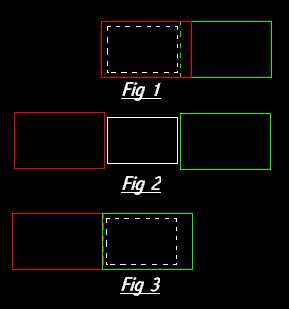Focal plane shutter
|
|
In camera design, a focal plane shutter is so-called because it is right in front of the focal (film) plane of the camera. The main advantages of the focal plane shutter is that the interchangeable lenses do not each need to have a central shutter built into them, and quite fast effective shutter speeds are possible.
The traditional type of focal plane shutter in 35mm cameras, pioneered by the Leica camera company, uses two shutter curtains that run horizontally across the film plane. For slower shutter speeds, the first curtain opens from (usually) right to left, and after the required time with the shutter open, the second curtain closes the aperture in the same direction. When the shutter is cocked again the shutter curtains are moved back to the original positions ready to be released.
Figure 1: The white rectangle represents the frame aperture through which the exposure is made. It is currently covered by the first shutter curtain, shown in red. The second shutter curtain shown in green is on the right side.
Figure 2: The first shutter curtain moves fully to the left allowing the exposure to made. At this point the flash is made to fire if one is attached and ready to do so.
Figure 3: After the required amount of exposure the second shutter curtain moves to the left to cover the frame aperture. When the shutter is recocked the shutter curtains are wound back to the right hand side ready for the next exposure.
Please note that this is a graphical representations only, the actual mechanisms are much more complex. For example, the shutter curtains actually roll on and off spools at either side of the frame aperture so as to use as little space as possible.
Faster shutter speeds are achieved by the second curtain closing before the first one has fully opened. This results in a slit aperture that travels horizontally across the film. Faster effective shutter speeds simply require a smaller slit aperture as the speed of travel of the shutter curtains is not normally varied. Using this technique modern SLR cameras are capable of shutter speeds of up to 1/2000, 1/4000 or even 1/8000 of a second.
Fp2.jpg
FP shutter, fast speed
Focal plane shutter, fast speed
Figure 1: The white rectangle represents the frame aperture through which the exposure is made. It is currently covered by the first shutter curtain, shown in red. The second shutter curtain shown in green is on the right side.
Figure 2: The first shutter curtain begins to move to the left allowing the exposure to made. Because the exposure requires a very fast shutter speed the second curtain begins to move across at a set distance from the first one.
Figure 3: The first shutter curtain continues to travel across the frame aperture followed by the second curtain. Note that it would be pointless to use an electronic flash with this shutter speed as the short duration flash would only expose a very small amount of the frame as the rest is covered by either the first or second shutter curtain.
Figure 4: The first shutter curtain finishes moving, followed closely by the second curtain which is now covering the frame aperture completely. When the shutter is recocked the shutter curtains are wound back to the right hand side ready for the next exposure.
Please note that this is a graphical representations only, the actual mechanisms are much more complex. For example, the shutter curtains actually roll on and off spools at either side of the frame aperture so as to use as little space as possible.
One limitation of the focal plane shutter is that the flash synchronisation speeds are generally quite slow. This is because the first curtain has to open fully and the second curtain must not start to close until the flash has fired, the fastest speed that can be used for flash sychronisation on a 35mm camera is normally 1/60 or 1/100 of a second. Many modern cameras have increased this to 1/250 of a second at the expense of reliability and greatly increased cost.
Cameras with focal plane shutters also produce image distortion when photographing fast moving objects or panning rapidly. Depending on the direction of travel, the recorded image can be seen to be elongated if motion is in the direction of the shutter blades, or foreshortened if travelling in the opposite direction to the shutter blades.
Most modern 35mm cameras now use the vertical travel metal blade shutter. This works in precisely the same way as the horizontal shutter; however, because of the shorter distance the shutter has to move (24mm as apposed to 36mm) and the metal construction, the shutter blades can travel across the film plane in less time. This can result in faster flash synchronisation speeds than are possible with the horizontal curtain focal plane shutter and can reliably sustain higher shutter speeds up to 1/500 s.de:Schlitzverschluss

